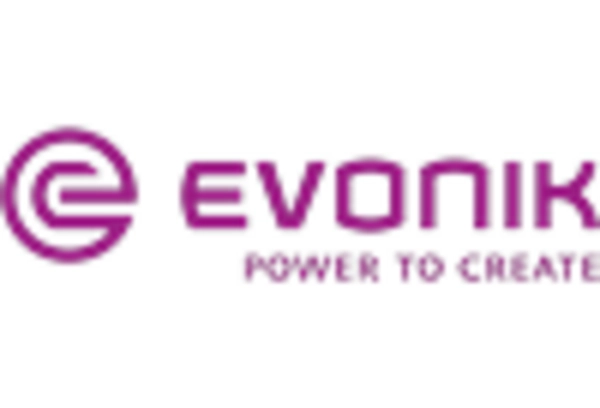Rising Demand for Food Packaging
The increasing demand for food packaging solutions is a pivotal driver for the Gas Barrier Membrane Market. As consumers become more health-conscious, the need for packaging that preserves food quality and extends shelf life has surged. Gas barrier membranes play a crucial role in preventing oxygen and moisture ingress, thereby maintaining the freshness of perishable goods. According to industry reports, the food packaging sector is projected to grow at a compound annual growth rate of approximately 4.5% over the next five years. This growth is likely to stimulate demand for advanced gas barrier membranes, which are essential for ensuring product integrity and safety. Consequently, manufacturers are investing in innovative materials and technologies to enhance the performance of gas barrier membranes, further propelling the market forward.
Growth in Construction Activities
The expansion of construction activities worldwide is significantly influencing the Gas Barrier Membrane Market. As urbanization accelerates, the need for effective building materials that provide insulation and moisture control has become paramount. Gas barrier membranes are increasingly utilized in construction to enhance energy efficiency and protect structures from environmental factors. The construction sector is expected to witness a growth rate of around 5% annually, driven by infrastructure development and housing projects. This trend suggests a rising adoption of gas barrier membranes in various applications, including roofing, walls, and foundations. As builders seek to comply with stringent energy regulations, the demand for high-performance gas barrier membranes is likely to increase, thereby fostering market growth.
Increasing Applications in Electronics
The rising applications of gas barrier membranes in the electronics sector are emerging as a key driver for the Gas Barrier Membrane Market. With the proliferation of electronic devices, the need for protective packaging that prevents moisture and gas infiltration is critical. Gas barrier membranes are essential in safeguarding sensitive electronic components, thereby enhancing product reliability and longevity. The electronics market is projected to grow at a rate of around 4% annually, driven by advancements in technology and consumer demand for innovative products. This growth is likely to spur the adoption of gas barrier membranes in various electronic applications, including displays, batteries, and circuit boards. As manufacturers prioritize quality and durability, the demand for high-performance gas barrier membranes is expected to rise, further propelling market dynamics.
Technological Innovations in Material Science
Technological advancements in material science are reshaping the Gas Barrier Membrane Market. Innovations such as the development of nanocomposite materials and bio-based polymers are enhancing the performance characteristics of gas barrier membranes. These advancements not only improve barrier properties but also contribute to sustainability efforts by reducing reliance on traditional petroleum-based materials. The market for advanced materials is projected to grow significantly, with estimates suggesting a potential increase of 6% annually. This growth is indicative of a broader trend towards integrating cutting-edge technologies into the production of gas barrier membranes, which could lead to enhanced functionality and application versatility. As manufacturers adopt these innovations, the Gas Barrier Membrane Market is likely to experience a transformation, catering to diverse industry needs.
Regulatory Support for Environmental Standards
Regulatory frameworks promoting environmental standards are becoming increasingly influential in the Gas Barrier Membrane Market. Governments are implementing stringent regulations aimed at reducing carbon footprints and enhancing energy efficiency across various sectors. These regulations often necessitate the use of advanced materials that can provide superior gas barrier properties, thereby driving demand for gas barrier membranes. The market is expected to benefit from these regulatory initiatives, as companies seek to comply with environmental standards while maintaining product performance. The anticipated growth in regulatory support could lead to a market expansion of approximately 5% over the next few years, as industries adapt to new compliance requirements. This trend underscores the importance of gas barrier membranes in achieving sustainability goals and meeting consumer expectations.

















Leave a Comment